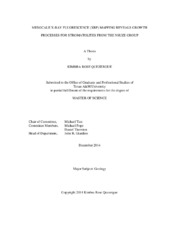| dc.description.abstract | Stromatolites are formed by physical, biological, and chemical processes, and combinations of specific processes produced the great variety of textures and morphologies in the geologic record. I here introduce a new technique for mesoscale chemical mapping for stromatolite interpretation. In particular, I use x-ray fluorescence microscopy (μXRF) to identify spatial associations between various elements (“fluorescence microfacies”) to infer the physical, biological, and chemical processes that produced the observed compositional distributions.
As a test case, elemental distributions from μXRF scans of stromatolites from the Nsuze Group (2.98 Ga) were analyzed to develop a fluorescence microfacies growth model. There are six major fluorescence microfacies: laminated dolostone, laminated chert, clotted dolostone and chert, stromatolite clast breccia, and cavity fill. Laminated dolostone is composed of microlaminated ferroan dolomite with isolated quartz, rutile, zircon, and unidentified Fe-rich grains. Individual dolomitic laminae contain syndepositional slumps, faults, or current structures. These laminae were likely formed primarily by trapping and binding microbial mats that precipitated carbonate mud at a shallow depth below the mat surface. Laminated chert is composed of microquartz with minor fine-grained phyllosilicates, heavy minerals, and rare sand-sized K-rich grains. Pinnacle structures, roll-ups, and oversteepened laminations suggest that this fluorescence facies was produced by the secondary silicification of microbial mats. The clotted dolostone and chert fluorescence microfacies are composed of intergrown chert and dolomite, which may appear as cryptically laminated clots. It forms high-relief cauliform mounds and had high original porosity that was frequently filled with intergrown chert and Mn-rich dolomitic cavity fill. Stromatolite clast breccias are matrix-supported breccias containing a mixture of stromatolitic clasts and heavy mineral grains. This facies was likely formed as lag deposits filling erosional scours and interstromatolite spaces. Cavities in the clotted dolostone and chert and stromatolite clast breccia fluorescence microfacies were filled by microquartz, Mn-rich dolomite, and partially dolomitized calcite (cavity fill fluorescence microfacies). | en |


